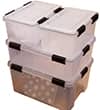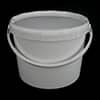Plastic is an invaluable material in pretty much every industry. From food packaging and storage to transportation, vehicles and more, its inherent properties are why it’s such a ubiquitous product.

© K-FK / Shutterstock.com
However, its wide use does present a problem: disposal. We currently produce more than 359 tonnes of plastic a year, of which only around 45% is recycled. Finding uses for plastic waste is important, as it might well increase our motivation for recycling.
So here’s a thought: could plastic waste be a good building material for various applications and projects?
It ticks a lot of construction boxes
Plastic is strong, durable, waterproof and lightweight. These are all ideal properties for construction because they help the product to hold up under strain and in varied weather conditions.
Importantly, plastic can remain a viable building material for more than 100 years, making it a good option for things like pipes, walls and more. Although this durability works against us from an environmental standpoint, that’s one of the reasons why it’s becoming ever more popular for other applications.
It requires minimal processing
First converted into pellets, which are melted down and cast or extruded into the desired shape; turning waste plastic into recyclable building materials isn’t a particularly difficult job.
Some construction initiatives simply use waste plastic in its existing form, especially bottles. Filling them with sand improves their weight and insulation, or the bottles can be stacked in hollow walls as they are.
Plastic is a good insulator
Heat-resistant and with the ability to remain airtight, these qualities make plastic an ideal construction material, as it can provide excellent thermal insulation.
Different polymers have different thermal properties, but their heat resistance can be increased: everyday plastics, which let’s face it are the most abundant, offer sufficient insulation when recycled and converted into building materials.
It’s cheap to produce
The cost of recycling plastic varies, but it can be anywhere from £0 to £450 per tonne, depending on the material type.
Polythene is one of the cheapest plastics to recycle and is drastically cheaper to produce than traditional construction materials like steel, concrete and brick.
As long as it can be recycled and manufactured at scale, plastic waste could massively assist the construction industry.
It can take on pretty much any shape
Within reason, it’s possible to mould plastic into pretty much any shape you choose. Manufacturers can use injection moulding, casting, rotomoulding and more to turn recycled plastic into any useful shape for building.
Granted, it wouldn’t necessarily work for supportive structures, but solid plastic building blocks can work well as wall building materials or paving stones.
Rotomoulding can be used for large hollow items that could be filled with other materials to improve heat and sound insulation.
Recycled plastic saves raw natural materials
Perhaps one of the more obvious benefits of using plastic waste for construction is that it saves having to harvest raw materials for construction products. Although things like clay, gravel, sand, etc. aren’t difficult to obtain, it’s surely better to avoid using these natural materials at all whenever possible.
Plastic waste already exists, and there’s more availability than can feasibly be dealt with through traditional streams. Turning it into building materials is therefore a viable option to help us improve our waste reduction endeavours. It’s fair to say, we have a lot of plastic waste on our hands, so it makes sense to think of ways to reuse it. Who knows, maybe it could prove to be the construction material of the future?





























































